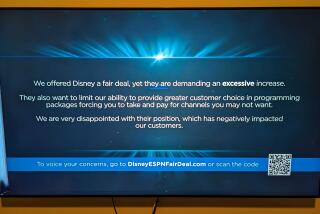ISPs Offering Slower Speeds
- Share via
High-speed Internet connections may be getting cheaper, but only if you’ll settle for a slower version of fast.
Hoping to attract Internet users who won’t pay the $50 or so a month for a typical broadband connection, some providers are moving away from a one-speed-fits-all approach and introducing a slower, lower-priced level of service.
Covad Communications Group Inc., one of the high-profile failures of the dot-com collapse, is taking another aggressive stab at the powerful telephone and cable TV monopolies that dominate broadband.
Rejuvenated by a stint in bankruptcy, the company recently launched a digital subscriber line, or DSL, service priced at $39.95 a month with an introductory rate of $21.95 for the first four months.
And Charter Communications Inc., the nation’s fourth-largest cable TV company, has been offering broadband for $30 or $35 a month on most of its systems in 40 states for at least a year.
The catch?
With download speeds of 200 to 250 kilobits per second, these “broadband lite” services are several times faster than a dial-up telephone connection but perhaps only a third as fast as a typical cable or DSL connection.
“It’s a little bit slower but a heck of a lot faster than dial-up and well worth the money,” said Steve Martin, a longtime America Online customer who recently switched to Covad at his home in San Jose.
The speed probably won’t satisfy those looking to download music or set up a Web site.
But Martin, a procurement officer for a technology company, considers his Covad connection speed more than sufficient for checking e-mail, downloading photographs and making travel arrangements.
“The killer application on the Internet is still e-mail, and as long as that’s the case, 200k [kilobits per second] is fine,” said Mark Kersey, an analyst for ARS Research.
It’s unclear whether tiered broadband will help reverse the price increases that cable and phone companies put in place as the dot-com meltdown wiped out competition from feisty rivals.
At the end of June, the average monthly charge for cable broadband was $45.31, up from $37.05 at the end of 2000, according to the latest market survey by ARS Research. DSL prices averaged $51.36 at midyear, up from $48.84 at the close of 2000, ARS reported.
Tiered pricing isn’t new to broadband. For years, customers willing to pay more than $50 a month have been able to get speedier connects.
But now, possibly because of the renewed competition, the big players also are toying with a tiered approach at the lower end.
AT&T; Broadband, which two weeks ago launched a faster tier of cable Internet service for $80 a month, also plans market trials with a lower-speed version this year.
Most of the companies dabbling with a lower-priced version of broadband are hoping to get dial-up users hooked on speed, confident that even the most price-conscious subscribers will quickly recognize what they were missing without an “always-on” connection.
“It’s addictive. They can never go back to dial-up,” said Charles Golvin, an industry analyst at Forrester Research.
Because the profit margins on entry-level offerings are less than robust, there are questions about whether such business models are any more viable than they were during the dot-com boom.
Covad believes that its model can work now that regulatory changes allow it to provide DSL over a customer’s existing phone line rather than a separately installed line.
Ideally, for players both big and small, any entry-level tier of service will serve as a steppingstone to higher-revenue plans.
Once people convert to broadband, getting them to pay $10 more for faster service is easier than getting them to initially switch from dial-up, Golvin and Kersey said.
More to Read
Inside the business of entertainment
The Wide Shot brings you news, analysis and insights on everything from streaming wars to production — and what it all means for the future.
You may occasionally receive promotional content from the Los Angeles Times.










